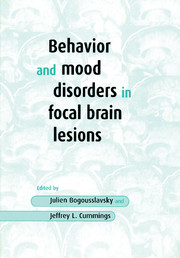Book contents
- Frontmatter
- Dedication
- Contents
- List of contributors
- Preface
- Acknowledgments
- 1 Emotional consequences of focal brain lesions: an overview
- 2 The evaluation of mood and behavior in patients with focal brain lesions
- 3 Methodological issues in studying secondary mood disorders
- 4 Emotional behavior in acute brain lesions
- 5 Depression and lesion location in stroke
- 6 Mood and behavior in disorders of the basal ganglia
- 7 Mania and manic-like disorders
- 8 Behavioral and emotional changes after focal frontal lobe damage
- 9 Disorders of motivation
- 10 Thalamic behavioral syndromes
- 11 Obsessive-compulsive disorders in association with focal brain lesions
- 12 Emotional dysprosody and similar dysfunctions
- 13 Temporal lobe behavioral syndromes
- 14 Neural correlates of violent behavior
- 15 Focal lesions and psychosis
- 16 Alterations in sexual behavior following focal brain injury
- 17 Anosognosia
- 18 Acute confusional states and delirium
- Index
3 - Methodological issues in studying secondary mood disorders
Published online by Cambridge University Press: 05 August 2016
- Frontmatter
- Dedication
- Contents
- List of contributors
- Preface
- Acknowledgments
- 1 Emotional consequences of focal brain lesions: an overview
- 2 The evaluation of mood and behavior in patients with focal brain lesions
- 3 Methodological issues in studying secondary mood disorders
- 4 Emotional behavior in acute brain lesions
- 5 Depression and lesion location in stroke
- 6 Mood and behavior in disorders of the basal ganglia
- 7 Mania and manic-like disorders
- 8 Behavioral and emotional changes after focal frontal lobe damage
- 9 Disorders of motivation
- 10 Thalamic behavioral syndromes
- 11 Obsessive-compulsive disorders in association with focal brain lesions
- 12 Emotional dysprosody and similar dysfunctions
- 13 Temporal lobe behavioral syndromes
- 14 Neural correlates of violent behavior
- 15 Focal lesions and psychosis
- 16 Alterations in sexual behavior following focal brain injury
- 17 Anosognosia
- 18 Acute confusional states and delirium
- Index
Summary
Introduction
This volume summarizes our current knowledge regarding the brain lateralization and topography of emotion and mood states. Whereas most of the chapters in this volume address specific forms of secondary mood disorders, including depression, mania, anxiety disorders, dysprosodias, apathy (and the evidence for the cerebral localization of each mood disorder), this chapter focuses on some of the key contentious issues that the reader should be aware of when reading the other chapters in this volume.
There are numerous challenges to studying the neurologic basis of emotions and mood states. Animal models are possible for some aspects of abnormal social behavior and emotional responsivity (Jarrell et al., 1987; Davis 1992), but are lacking for mood states. Even in humans, the conceptualization of emotions and mood states requires subjective interpretation. The lack of clear definitions of emotions and mood states that go beyond a description of feelings or tone also limits the ability of researchers to easily validate or reject even the most simple of theoretical models. Granted, there are serious theories regarding fundamental social cognitive behavior, but it is usually the observed and measured behavioral expression of emotional or mood-induced actions (or lack of action) that are utilized in these theories. Nevertheless, there are a large number of neuropsychiatric studies investigating emotion and mood state changes that follow focal brain lesions or the onset of neurodegenerative diseases. In addition, sophisticated functional neuroimaging techniques now allow for the identification of patterns of brain activity induced by mood state manipulations in patients and normal volunteers. The large number of lesion and neuroimaging studies in the literature reflects an explosion of data begging for adequate theory. This chapter emphasizes which variables are critical for the methodological interpretation of those data.
Basic concepts
A basic starting point for the neuropsychiatric investigation of mood is to select generally agreed upon definitions of mood and mood disorders, both primary and secondary, and to describe the way in which mood states interact with social and cognitive behaviors.
Definitions of mood and mood disorders
Consistency in defining mood and mood state disorders is essential if investigators are to compare results across studies and sites.
- Type
- Chapter
- Information
- Behavior and Mood Disorders in Focal Brain Lesions , pp. 48 - 64Publisher: Cambridge University PressPrint publication year: 2000



